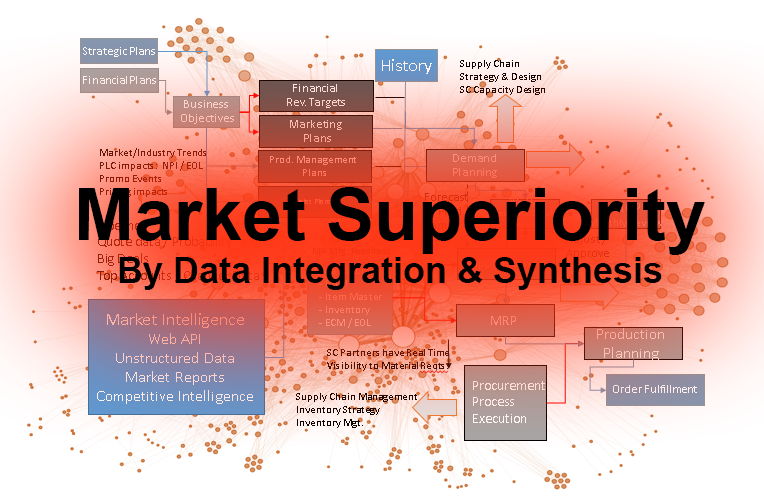
Data Integration and Synthesis
Ask any CFO if they believe, “Data is the language of business.“
Today’s companies deploy multiple applications to boost the “language” of business from a dull hum to a resonating roar. Each business unit generates data in a variety of formats from underneath layers of management and ends up creating data silos. While not a significant issue at the department level, problems forced upon business by a global economy require business leaders to overcome silos and master their data to grow revenue, cut costs, and improve efficiency. The problem isn’t data itself. It is the ongoing and volatile changes of a global economy that threaten to out pace traditional business processes and make it problematic for business leaders to achieve repeatable success.
PROBLEM – We work in a global economy:
- Economies are more volatile
- Markets are more fragmented
- Technology innovations are faster
- Competition is numerous and everywhere
Data that can provide actionable insights for superior decision-making is therefore of immense value. Business leaders already make use of business (BI), market (MI), and competitive intelligence (CI). The promise by industry visionaries is that, somehow, Big Data and the Internet of Things (IoT) will provide “actionable insights” for strategic planning. But strategic planners struggle to summarize their data when functional areas – the business units – generate data without any incentive to integrate, share, or think outside their domains of expertise. Furthermore, data is often dirty and contains gaps which leads to inaccurate and unreliable forecasts. The talent necessary to process (prepare, clean, and blend) data currently remains limited to a small portion of the available workforce.
CHALLENGE – Insights are not where we need them:
- Silos of: data, domain experts, chain of command
- Dirty and incomplete data reduces reliability
- Talent scarcity limits access to advanced analytics
Historically, in-house IT would build custom tools to consolidate and manage data. But the pace of technology and a busy analytics market has led many departments to end-run IT in favor of immediate resolution. Unfortunately, whenever a business unit purchases another point-solution they compound data silos. In the attempt to master data and out pace competitors, three common scenarios have emerged:
- The dismissal of data as a critical asset or generator of value – reliance on historical trends leaves future outcomes to assumption
- The internal analytics initiative – year-long coding developments and six-figure software installments end up obsolete upon completion
- The purchase of more applications – more software and more training, even with “self-service” tools does not ensure “intelligence”
Take it on the chin if you have experienced any of the three scenarios because this story is about those who finally overcome silo barrier so they could support faster and better decisions to win the battle for supremacy in a global economy.
Again, the volume of data is not the fundamental business challenge; is the manner in which data is processed from the source to actionable insight. Organizational hierarchy places domain expertise into silos by the nature of communications between managers and employees. Data is treated the same way, reported up from a silo point-of-view along the chain of command. When a company “summarizes” their data in a bottoms-up approach, they inevitably reduce context and rely on human filters. The reality is that domain experts are not looking across departments in the same way as a CFO or CEO. The enterprise which thinks in silos also sees in silos.
So break from the traditional reporting paradigm. Data transcends silos because it is the product of the business processes which are interdependent with each other. Enterprise Application Systems are mostly in-congruent but, when their data is integrated and synthesized by the business process in a top-down approach, a rich and holistic view of the enterprise emerges. The network of interdependent business processes is what delivers actionable insights to CXOs for repeatable success, not like the summaries of revenue and EBITA.
RESOLUTION – Step back from silos, integrate data:
- View the business by its interdependent business processes
- Maps of the business model cover gaps in department functions
- Actionable insights feed faster cycles of plan, execute, measure
Visionary leaders who embrace this paradigm shift benefit from from accessing a ‘nerve center’ of business and market data. Visualizing the business model enables proactive business management. Their business becomes an Intelligent Enterprise which produces revenue generating insights, cuts costs of managing data across disparate systems, and improves efficiencies in strategic planning speed and accuracy.
- Gain a holistic view of the enterprise
- Predict the future and outcomes
- Prescribe optimal decisions
- Achieve Market Superiority
The pains and problems of a global economy are sure to affect your competitors as much as you. That is where data silos and a fractured market are a strategic advantage to those Executives can see their enterprise in a top-down approach. As your enterprise makes superior decisions it pulls ahead of competitors who cannot keep up in cycles to plan, execute, and measure. The company that can plan, execute, and measure the fastest is the company that gains market superiority.
